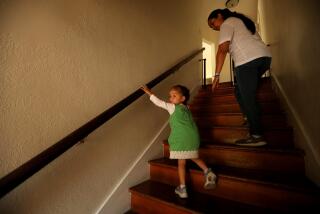Baby-Boomers Seek Traditional Shelter
- Share via
WASHINGTON — Sales of new and existing houses continues to “go through the roof”--thanks to the lowest level of mortgage rates in the 1980s. Indeed, selling conditions are so euphoric for realtors and home builders that they could forget that the dominant prospective home buyers in the next 15 years will be the “early middle-aged” baby-boomers of the post WW II years.
Evidence of a consistent strong housing market through the remainder of this century has been put together by the Housing Futures Consumer Survey conducted by the Joint Center for Housing Studies of M.I.T. and Harvard University. Two factors were highlighted for continued high incidence of home ownership:
--The baby-boom generation, whose members are now in the 21-to-40 age group, are expected to be looking for large, owner-occupied single houses to satisfy their growing families and mounting social-economic (spell that E-G-O) status.
These “greening” baby-boomers are reaching their peak earning capacity, with most of them expected to have incomes over $30,000 in the 1990s.
William C. Apgar, Jr., director of the Housing Futures program at M.I.T.-Harvard wrote recently in Real Estate Today: “Compared to previous generations, baby-boomers have relatively high incomes . . . that should magnify further the likely effects they will have on the housing market of the 1980s.
The Housing Futures survey indicated that this bumper crop of early middle-aged home-seekers will set sights on ample interior space and yard privacy. They are expected to find those amenities and others that are synonymous with the traditional single-family detached house.
“That sounds like ‘old hat’ to me,” commented veteran Washington realtor Earl M. Farr. “It can hardly be surprising that young affluent young people would now prefer the kind of house in which most of them grew up. If they can afford to own a single detached house, young married and single will choose it 9 times out of 10.”
The Housing Futures Survey, which covered some 5,000 households in 1983 and then again in 1984, showed that 30% of U.S. households are extremely satisfied with their current housing and only 7% are somewhat or very dissatisfied. Significantly, much of the dissatisfaction was with the lack of interior space and the lack of privacy in the outside yard or lot.
Also meaningful, according to the study, is that the desire for comfortable housing “cuts across age groups.” Apgar wrote that interest in owning a house and in moving up to a single detached house rated highest among middle-aged households. Even more significant is the report that 48% of young renters (aged 30 or less) believe they will move to an owner-occupied dwelling in the next five years. And, naturally, both the young and middle-aged household members are expecting to move up and into larger, more expensive houses.
Somewhat surprising, is a refutation of the prevalent notion that empty-nester couples (whose children have grown and left) are interested in moving to smaller houses. The Housing Futures survey shows that two of three married-couple households aged 55 to 75 who sold their home from 1978 to 1983 moved into another dwelling “as big or bigger than the one they sold.”
Finally, the survey found that first-time buyers will continue to have affordability problems, “especially if tax reform should make ownership less favorable,” economically and tax-wise, than does current IRS regulations. Another negative factor for the housing industry is that the 20-25 age group is now peaking and the mature baby boom era will be followed by a period when fewer young people will reach the marrying and the home-buying age.
More to Read
Inside the business of entertainment
The Wide Shot brings you news, analysis and insights on everything from streaming wars to production — and what it all means for the future.
You may occasionally receive promotional content from the Los Angeles Times.










